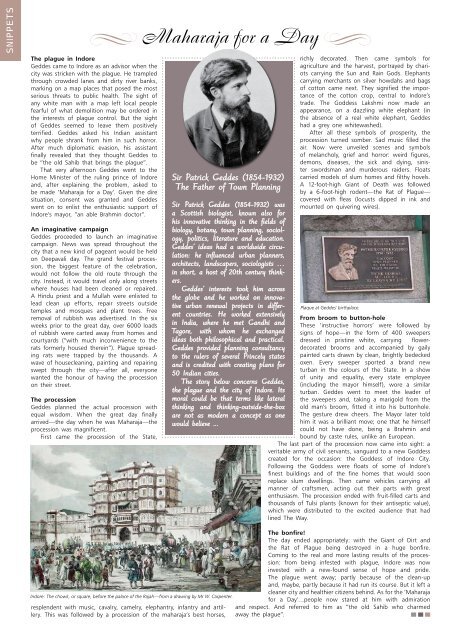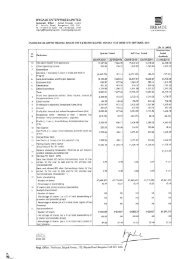BRIGADE INSIGHT - Brigade Group
BRIGADE INSIGHT - Brigade Group
BRIGADE INSIGHT - Brigade Group
Create successful ePaper yourself
Turn your PDF publications into a flip-book with our unique Google optimized e-Paper software.
22<br />
SNIPPETS<br />
The plague in Indore<br />
Geddes came to Indore as an advisor when the<br />
city was stricken with the plague. He trampled<br />
through crowded lanes and dirty river banks,<br />
marking on a map places that posed the most<br />
serious threats to public health. The sight of<br />
any white man with a map left local people<br />
fearful of what demolition may be ordered in<br />
the interests of plague control. But the sight<br />
of Geddes seemed to leave them positively<br />
terrified. Geddes asked his Indian assistant<br />
why people shrank from him in such horror.<br />
After much diplomatic evasion, his assistant<br />
finally revealed that they thought Geddes to<br />
be “the old Sahib that brings the plague”.<br />
That very afternoon Geddes went to the<br />
Home Minister of the ruling prince of Indore<br />
and, after explaining the problem, asked to<br />
be made ‘Maharaja for a Day’. Given the dire<br />
situation, consent was granted and Geddes<br />
went on to enlist the enthusiastic support of<br />
Indore’s mayor, “an able Brahmin doctor”.<br />
An imaginative campaign<br />
Geddes proceeded to launch an imaginative<br />
campaign. News was spread throughout the<br />
city that a new kind of pageant would be held<br />
on Deepavali day. The grand festival procession,<br />
the biggest feature of the celebration,<br />
would not follow the old route through the<br />
city. Instead, it would travel only along streets<br />
where houses had been cleaned or repaired.<br />
A Hindu priest and a Mullah were enlisted to<br />
lead clean up efforts, repair streets outside<br />
temples and mosques and plant trees. Free<br />
removal of rubbish was advertised. In the six<br />
weeks prior to the great day, over 6000 loads<br />
of rubbish were carted away from homes and<br />
courtyards (“with much inconvenience to the<br />
rats formerly housed therein”). Plague spreading<br />
rats were trapped by the thousands. A<br />
wave of housecleaning, painting and repairing<br />
swept through the city—after all, everyone<br />
wanted the honour of having the procession<br />
on their street.<br />
The procession<br />
Geddes planned the actual procession with<br />
equal wisdom. When the great day finally<br />
arrived—the day when he was Maharaja—the<br />
procession was magnificent.<br />
First came the procession of the State,<br />
Maharaja for a Day<br />
Sir Patrick Geddes (1854-1932)<br />
The Father of Town Planning<br />
Sir Patrick Geddes (1854-1932) was<br />
a Scottish biologist, known also for<br />
his innovative thinking in the fields of<br />
biology, botany, town planning, sociology,<br />
politics, literature and education.<br />
Geddes’ ideas had a worldwide circulation:<br />
he influenced urban planners,<br />
architects, landscapers, sociologists …<br />
in short, a host of 20th century thinkers.<br />
Geddes’ interests took him across<br />
the globe and he worked on innovative<br />
urban renewal projects in different<br />
countries. He worked extensively<br />
in India, where he met Gandhi and<br />
Tagore, with whom he exchanged<br />
ideas both philosophical and practical.<br />
Geddes provided planning consultancy<br />
to the rulers of several Princely states<br />
and is credited with creating plans for<br />
50 Indian cities.<br />
The story below concerns Geddes,<br />
the plague and the city of Indore. Its<br />
moral could be that terms like lateral<br />
thinking and thinking-outside-the-box<br />
are not as modern a concept as one<br />
would believe ...<br />
richly decorated. Then came symbols for<br />
agriculture and the harvest, portrayed by chariots<br />
carrying the Sun and Rain Gods. Elephants<br />
carrying merchants on silver howdahs and bags<br />
of cotton came next. They signified the importance<br />
of the cotton crop, central to Indore’s<br />
trade. The Goddess Lakshmi now made an<br />
appearance, on a dazzling white elephant (in<br />
the absence of a real white elephant, Geddes<br />
had a grey one whitewashed).<br />
After all these symbols of prosperity, the<br />
procession turned somber. Sad music filled the<br />
air. Now were unveiled scenes and symbols<br />
of melancholy, grief and horror: weird figures,<br />
demons, diseases, the sick and dying, sinister<br />
swordsman and murderous raiders. Floats<br />
carried models of slum homes and filthy hovels.<br />
A 12-foot-high Giant of Death was followed<br />
by a 6-foot-high rodent—the Rat of Plague—<br />
covered with fleas (locusts dipped in ink and<br />
mounted on quivering wires).<br />
Plaque at Geddes' birthplace.<br />
From broom to button-hole<br />
These ‘instructive horrors’ were followed by<br />
signs of hope—in the form of 400 sweepers<br />
dressed in pristine white, carrying flowerdecorated<br />
brooms and accompanied by gaily<br />
painted carts drawn by clean, brightly bedecked<br />
oxen. Every sweeper sported a brand new<br />
turban in the colours of the State. In a show<br />
of unity and equality, every state employee<br />
(including the mayor himself), wore a similar<br />
turban. Geddes went to meet the leader of<br />
the sweepers and, taking a marigold from the<br />
old man’s broom, fitted it into his buttonhole.<br />
The gesture drew cheers. The Mayor later told<br />
him it was a brilliant move; one that he himself<br />
could not have done, being a Brahmin and<br />
bound by caste rules, unlike an European.<br />
The last part of the procession now came into sight: a<br />
veritable army of civil servants, vanguard to a new Goddess<br />
created for the occasion: the Goddess of Indore City.<br />
Following the Goddess were floats of some of Indore’s<br />
finest buildings and of the fine homes that would soon<br />
replace slum dwellings. Then came vehicles carrying all<br />
manner of craftsmen, acting out their parts with great<br />
enthusiasm. The procession ended with fruit-filled carts and<br />
thousands of Tulsi plants (known for their antiseptic value),<br />
which were distributed to the excited audience that had<br />
lined The Way.<br />
Indore: The chowk, or square, before the palace of the Rajah—from a drawing by Mr W. Carpenter.<br />
resplendent with music, cavalry, camelry, elephantry, infantry and artillery.<br />
This was followed by a procession of the maharaja’s best horses,<br />
The bonfire!<br />
The day ended appropriately: with the Giant of Dirt and<br />
the Rat of Plague being destroyed in a huge bonfire.<br />
Coming to the real and more lasting results of the procession:<br />
from being infested with plague, Indore was now<br />
invested with a new-found sense of hope and pride.<br />
The plague went away; partly because of the clean-up<br />
and, maybe, partly because it had run its course. But it left a<br />
cleaner city and healthier citizens behind. As for the ‘Maharaja<br />
for a Day’…people now stared at him with admiration<br />
and respect. And referred to him as “the old Sahib who charmed<br />
away the plague”.

















